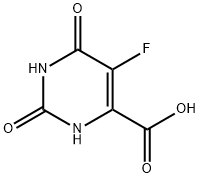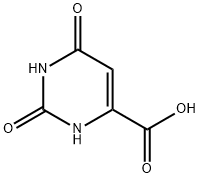PRODUCT Properties
| Melting point: | 278 °C (dec.)(lit.) |
| Boiling point: | 143°C (rough estimate) |
| Density | 1.6154 (estimate) |
| storage temp. | Sealed in dry,Store in freezer, under -20°C |
| solubility | NH4OH 4 M: 50 mg/mL, clear, faintly yellow |
| pka | 2.04±0.20(Predicted) |
| form | solid |
| color | Pale yellow |
| Merck | 14,4176 |
| InChIKey | LODRRYMGPWQCTR-UHFFFAOYSA-N |
| CAS DataBase Reference | 703-95-7(CAS DataBase Reference) |
Description and Uses
5-FOA(5-Fluoroorotic acid ) has become a valuable tool for research in the field of molecular genetics. It has been employed in the selection of resistant strains of Saccharomyces cerevisiae that possess a mutant URA3 gene which renders them orotidine-5'-phosphate decarboxylase deficient. 5-FOA is coverted to 5-fluorouridine monophosphate (5-FUMP) in yeast cells, which can become incorporated into RNA or metabolized to the highly toxic 5-fluoro-2’-deoxyuridine monophosphate (5-FdUMP). 5-FdUMP is a potent inhibitor of thymidylate synthase (TS), causing the cessation of DNA synthesis. More recently, 5-FOA has been shown to possess potent antimalarial activity against both chloroquine-susceptible and chloroquine-resistant clones of Plasmodium falciparum. Studies indicate that TS is the primary target of 5-FOA in malarial parasites. The combination of 5-FOA and uracil has been effective in treating mice infected with Plasmodium yoelli. 5-FOA may also have potential in the treatment of human malarial infections when used in combination with other agents.
Safety
| Symbol(GHS) |  GHS07 |
| Signal word | Warning |
| Hazard statements | H302-H315-H319-H335 |
| Precautionary statements | P264-P270-P301+P312+P330-P501-P261-P305+P351+P338 |
| Hazard Codes | Xn,Xi |
| Risk Statements | 22-36/37/38 |
| Safety Statements | 26-36-36/37/39-27 |
| WGK Germany | 3 |
| RTECS | UV7800000 |
| F | 10 |
| HazardClass | IRRITANT |
| HS Code | 29335990 |





